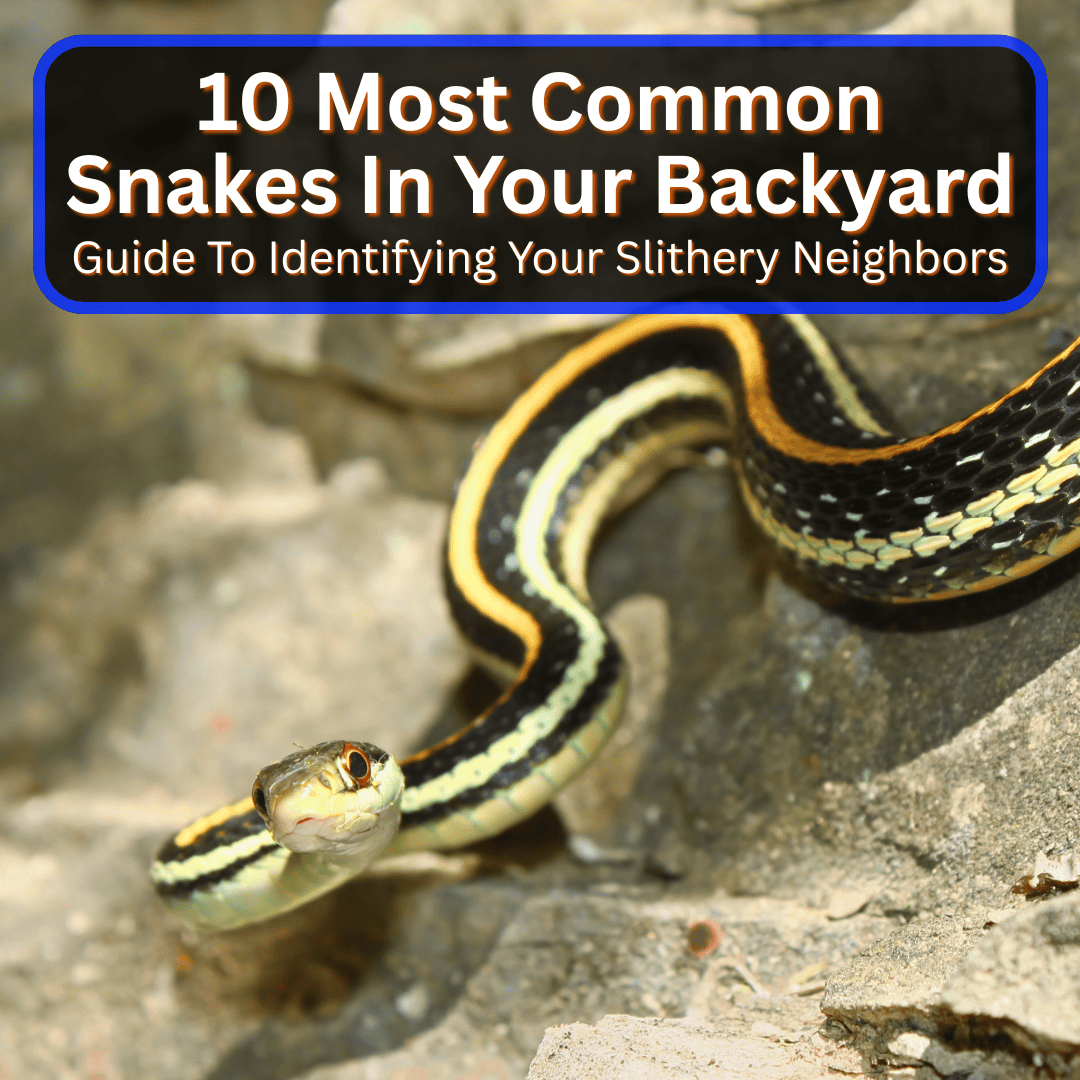
Getting familiar with the usual backyard snakes can help you figure out which ones are harmless and which deserve a little more caution.
Most of the time, the snakes you run into are actually doing you a favor by eating pests like mice and insects.
From striped garter snakes to smooth green snakes, each species has its own favorite hangout.
Some tuck themselves under garden beds, others stick close to water or wander through the grass.
If you know what draws them in and how to tell them apart, it’s a lot less stressful when you bump into one outside.
Most Common Snakes In Your Backyard
Most snakes that show up in our backyards are harmless, but if you live in an area with venomous snakes, you can never be sure. Unless you know how to identify the most common species you might see, that is! So here they are.
1. Garter Snake
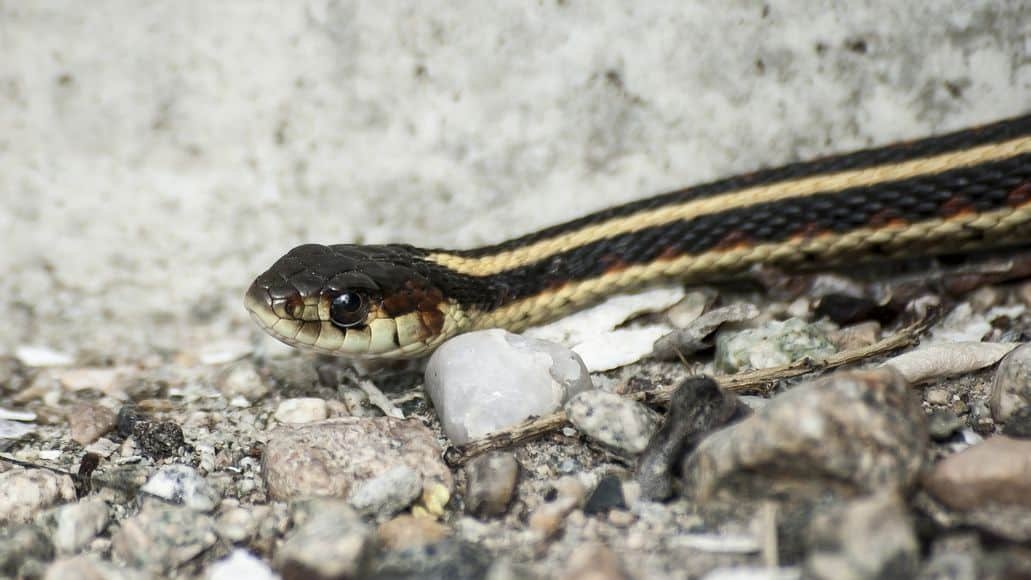
Garter snakes are probably the most common snake you’ll see around your yard. These friendly reptiles live just about everywhere in the U.S. Look for their signature stripes running the length of their bodies. The colors can vary, but those long lines are always there.
They like hiding under rocks, in tall grass, or anywhere there’s yard debris. Garden beds are a favorite spot, too. Garter snakes are great for your garden. They snack on slugs, grasshoppers, and small rodents that can wreck your plants.
No need to panic if you see one—garter snakes aren’t dangerous. Bites are rare, and if it happens, it’s just a mild irritation. They’re out and about most often in spring and summer, either basking in the sun or hunting for a meal.
Some people call them “garden snakes” because they’re such regulars in backyard gardens. They’re like little pest patrols. If you have a few garter snakes hanging around, you’re in luck—they’re keeping lots of other critters away from your plants.
2. Eastern Rat Snake
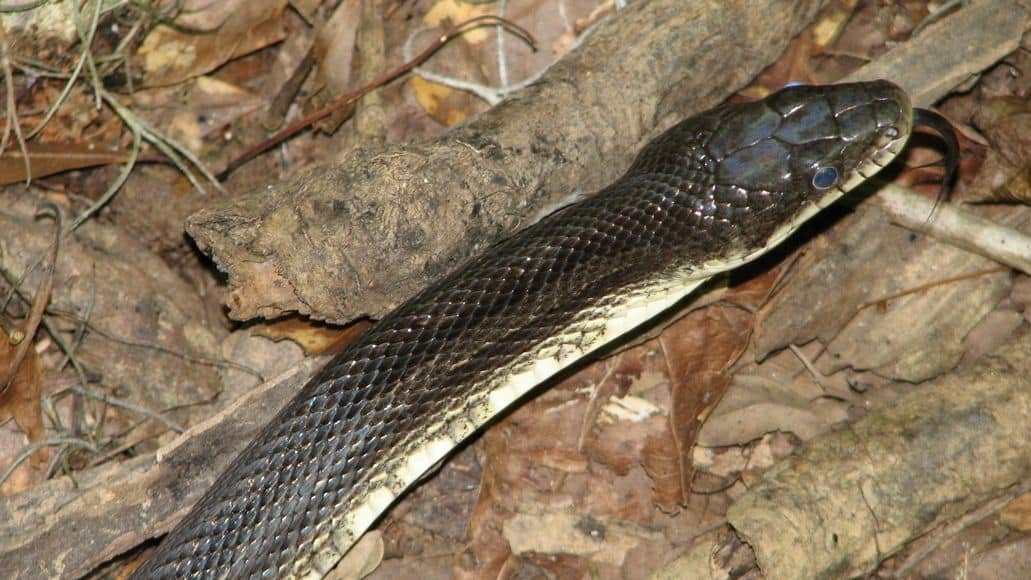
If you live in the eastern US, you’ve probably seen an Eastern Rat Snake at some point. They’re easy to spot with their shiny black scales and impressive size.
These snakes can get pretty big—sometimes over six feet long. But they’re harmless to people. You might catch one climbing a tree, hiding in a barn, or even up in your attic. They’re surprisingly good climbers and like to hunt in high places.
Eastern Rat Snakes are actually helpful guests. They eat rats, mice, and other rodents that would otherwise cause trouble in your house or garden. You’ll find them from Florida up to Vermont, living in woods, fields, swamps, and even neighborhoods.
If one turns up in your yard, just remember it’s helping keep pests in check. These gentle snakes usually slip away as soon as they notice you.
3. Bullsnake
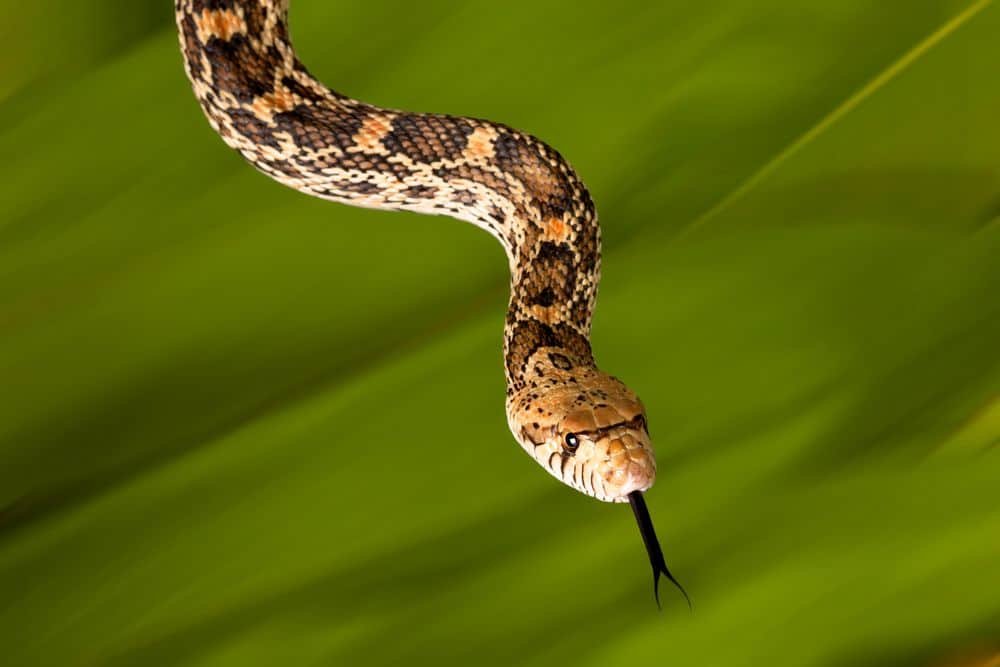
At first glance, you might think a bullsnake is a rattlesnake. They look similar and they are among the biggest snakes in North America and can get really long. Bullsnakes like open spaces—fields, prairies, and especially the central U.S. where there’s room to roam.
They aren’t venomous, so you don’t need to worry about their bite. Still, they’re clever. When scared, they mimic rattlesnakes. If they feel threatened, they’ll coil up, hiss, and even shake their tails to sound like a rattler. It’s all for show.
Bullsnakes do a lot of good by eating rodents like mice and rats, which can be a real problem in your garden or around your house. Their strong bodies let them catch prey by squeezing it in the classic constrictor style.
If you see one, just give it some space. Bullsnakes would rather avoid people and will usually move on if you leave them alone.
4. Ring-Necked Snake
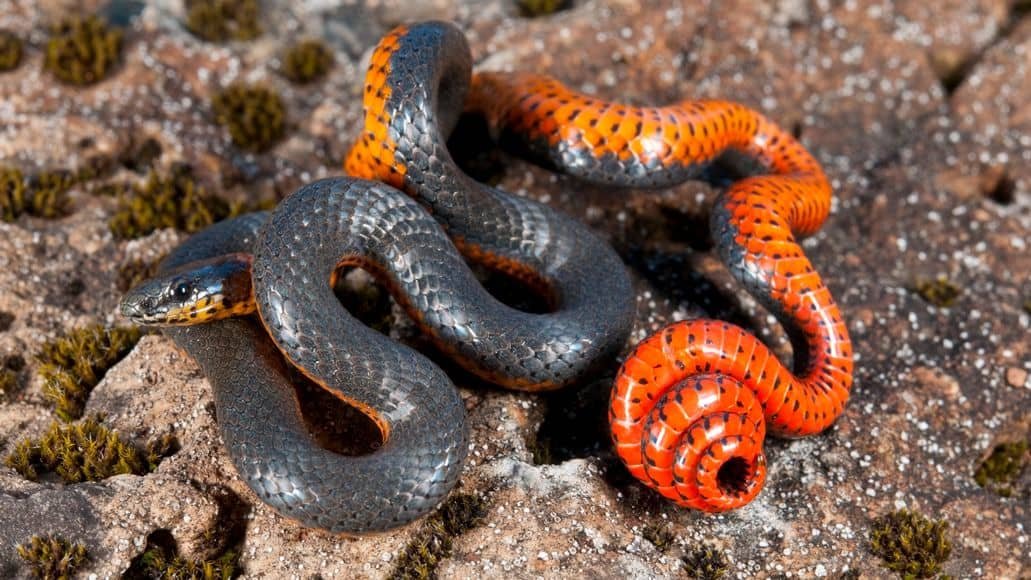
This little snake is easy to miss. Ring-necked snakes are small—usually just 8 to 14 inches long. They’re dark gray or black, but what really stands out is the bright yellow or orange ring around their neck. That band makes them easy to recognize.
Ring-necked snakes won’t hurt you or your pets. They’re actually helpful because they eat pests like slugs and insects. Look for them in the late morning, hiding under rocks, logs, or garden debris, especially in moist spots.
They’re common just about everywhere in the US. They live in gardens, woods, even city backyards.
If you find one, don’t stress. They’re gentle and rarely bite. When scared, they’ll curl their tails and flash their colorful bellies as a warning. These little guys help keep your garden healthy by eating pests. If you spot one, you’ve got a good thing going in your backyard.
5. Milk Snake
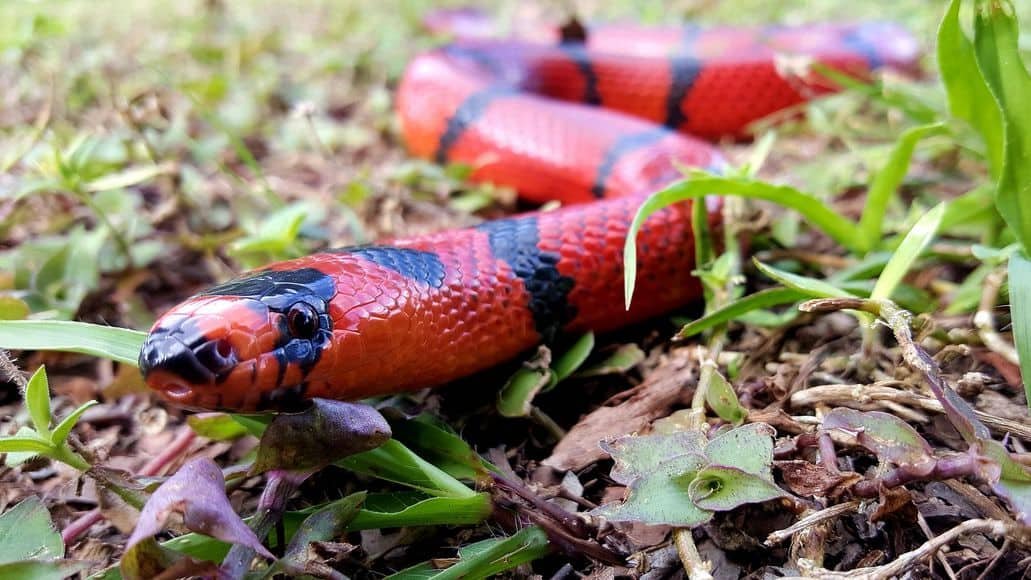
Milk snakes sometimes get mistaken for something dangerous. Their red, black, and yellow bands look a lot like the venomous coral snake. This is no accident. It’s called defensive mimicry. The milk snake copies coral snake colors to scare off predators. Smart move, really.
Milk snakes are totally harmless to people. They’re shy and would rather avoid you if they can. Look for them in fields or along forest edges. They like to hide under rocks, logs, or in tall grass during the day.
They’re great at keeping pests in check, eating small mammals and reptiles. Once they’ve cleared out the rodents, they’ll usually move on to new hunting grounds.
If you see a milk snake, count yourself lucky. They’re natural rodent control. You can move one with gloves if you really need to, but honestly, they’re more helpful than harmful and most people just let them be.
6. Dekay’s Brown Snake
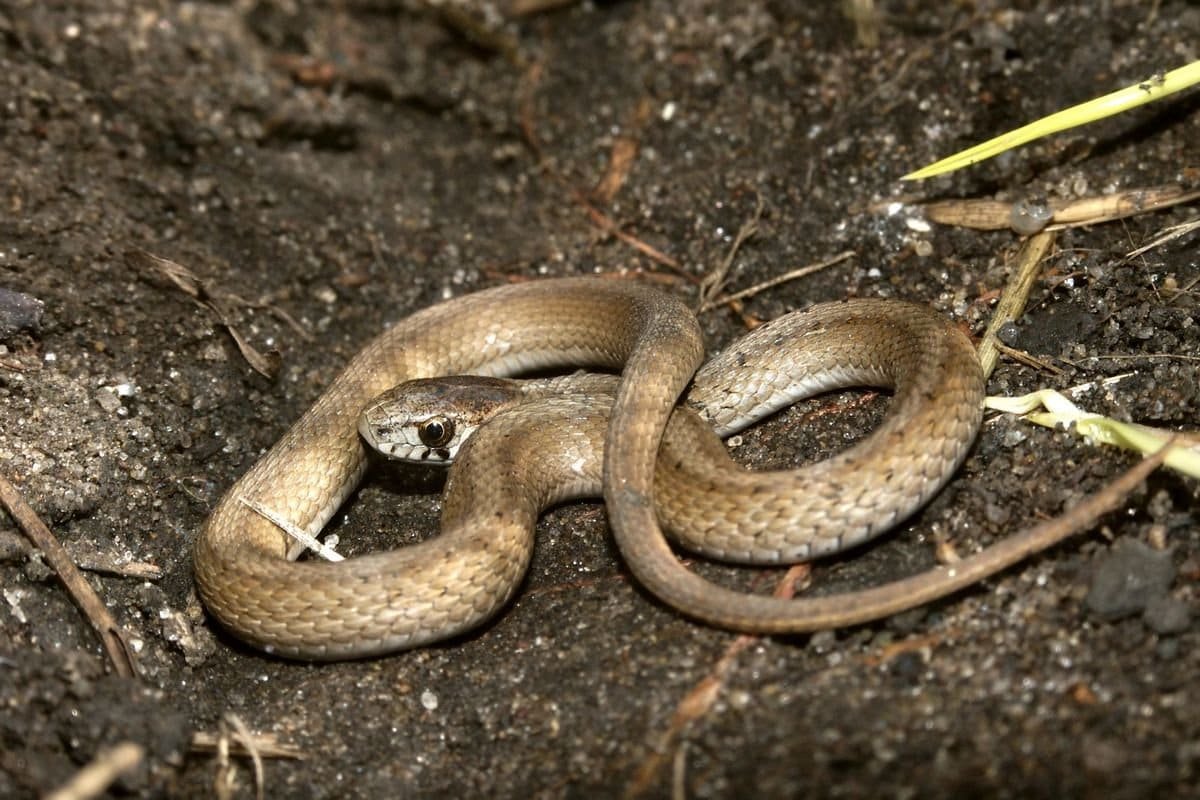
Dekay’s brown snake blends in so well, you might not even notice it’s there. These small snakes are experts at hiding. They’re usually tan or brown with two rows of dark spots down their backs, linked by a thin dark line. Some have a lighter stripe between the rows.
If they get scared, they puff up and flash white skin between their scales. Their bellies are cream or pink, and their heads are brown or gray with dark spots behind the eyes.
Dekay’s brown snakes are harmless. They don’t have venom and rarely bite. They’re actually handy to have around the garden. They eat slugs and earthworms, so they help protect your plants naturally. Less need for chemical pest control.
They’re city survivors, too. You’ll find them in busy places like New York or DC, hiding under rocks, logs, or garden debris during the day.
7. Western Ribbon Snake
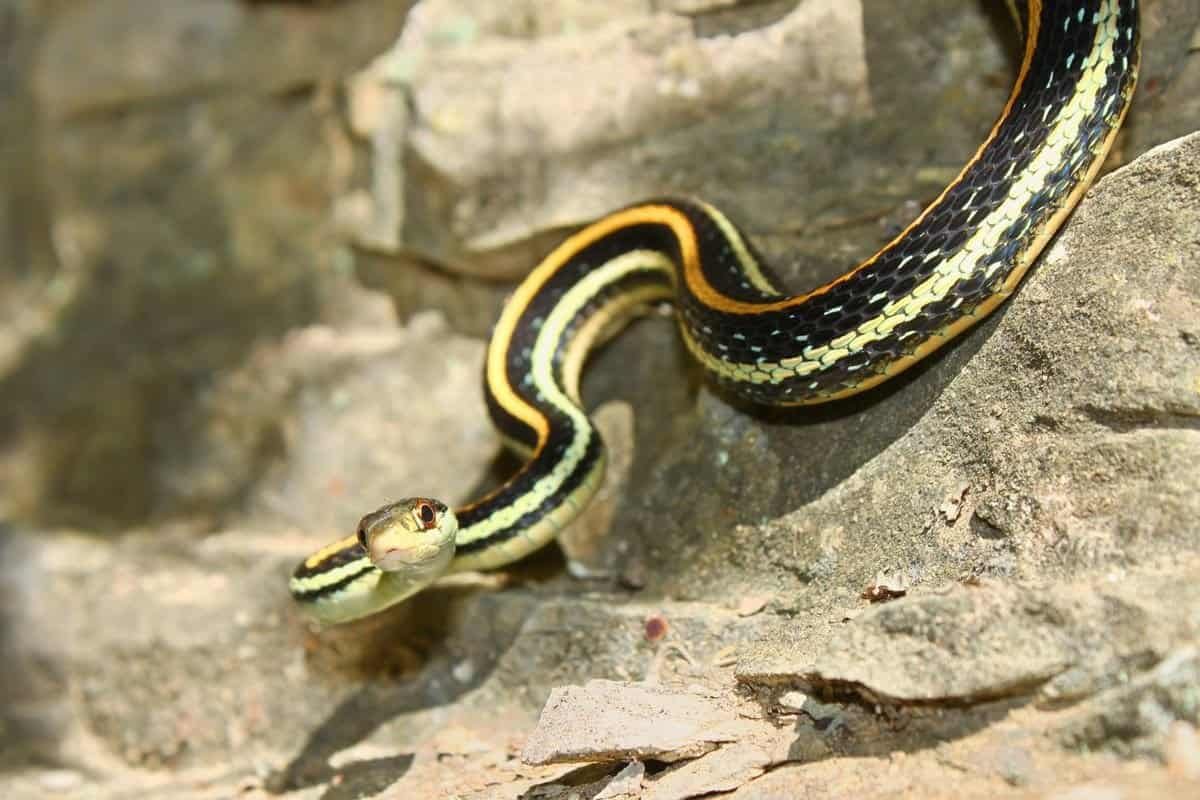
Western ribbon snakes hang out near water in your backyard. They’re slim, with a thin neck and body. They are hard to miss once you know what to look for. They’re brown to black with three stripes down their backs. The middle yellow stripe is the real standout.
Ribbon snakes are non-venomous and harmless. They stick close to ponds, streams, or other wet spots. They’re quick swimmers and climbers, often darting through grass or along the water’s edge.
You’ll see them most at dawn and dusk in spring and fall. When it’s hot, they’re more active at night to beat the heat. Ribbon snakes are pretty skittish. They’ll take off fast if they notice you.
They help out by eating small frogs, fish, and insects, so having them around is actually good for your garden’s balance.
8. Common Kingsnake
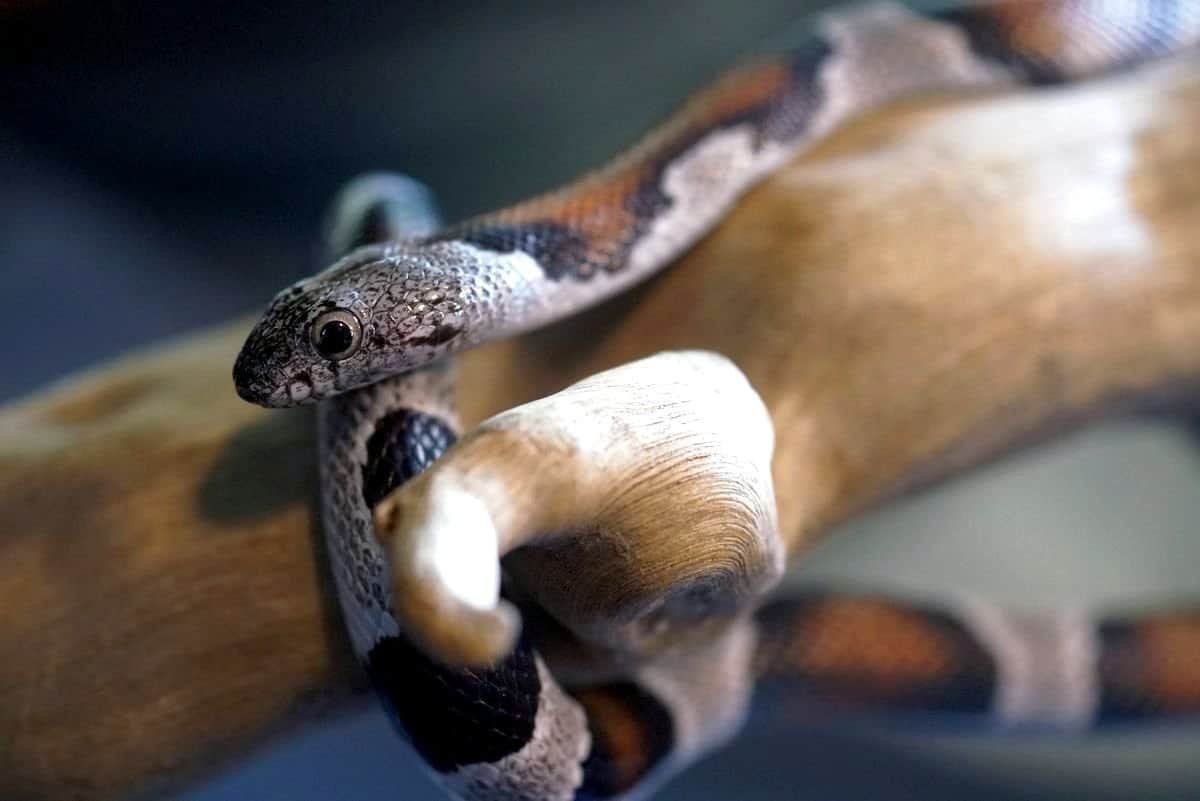
The common kingsnake is a real asset in the backyard. They’re not a threat to people and can even help keep your yard safer.
Kingsnakes are strong constrictors. They wrap around their prey to catch it. But don’t worry, they’re not interested in humans. They eat all sorts of animals—birds, mice, lizards—and, maybe best of all, they’ll even eat venomous snakes like copperheads and rattlesnakes.
They’re found throughout the southern states, adapting to lots of environments. If you spot a kingsnake, that’s good news. They help cut down on harmful snakes and rodents.
Kingsnakes have smooth scales and come in a mix of colors—some have bands, some have stripes. They’re usually pretty quiet and active during the day. They stick to places with good hiding spots, like rocks, logs, thick plants, where they can stay out of sight.
9. Coachwhip Snake
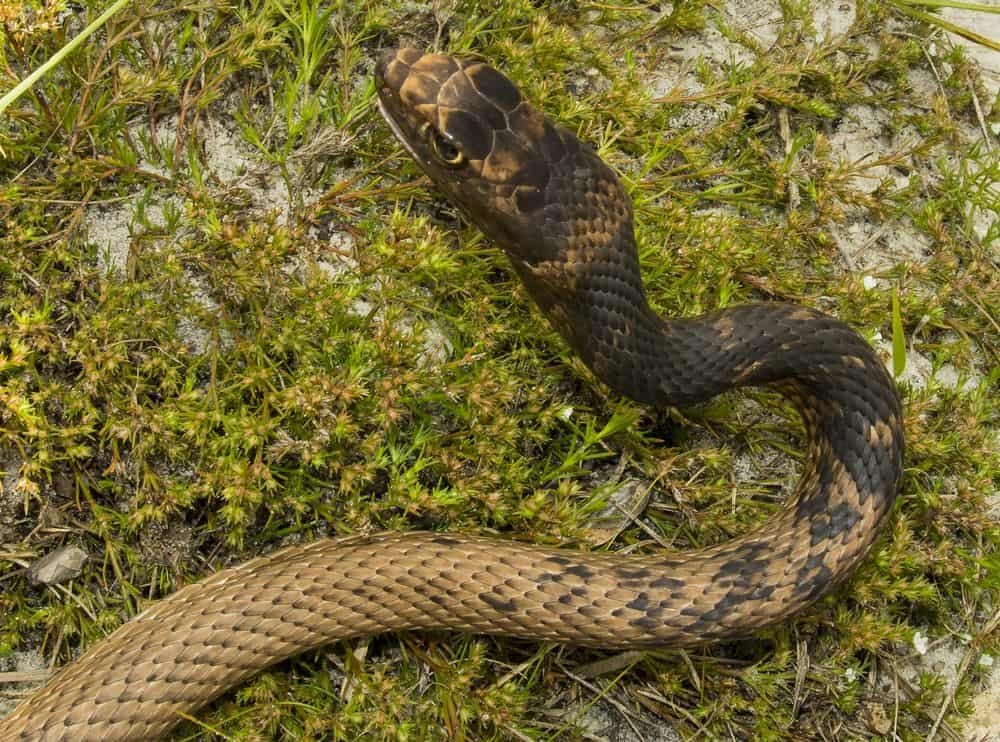
If you live in the western or southern U.S., you might see a coachwhip snake. They’re long, skinny, and nonvenomous. They pose no danger to you.
Coachwhips get their name from their tail. The pattern looks a bit like a braided whip. They’re incredibly quick and can grow over six feet long. Their thin bodies let them zip through grass and bushes in no time.
Young coachwhips look different from adults, with tan coloring, darker bands, and white markings on the head and neck. If you run into one, there’s no need to worry. Coachwhips are harmless and actually help control pests by eating small animals.
They like open areas with grass, rocks, or logs, and they’ll bask in sunny spots but hide under debris or in brush piles when it’s hot out.
10. Smooth Green Snake
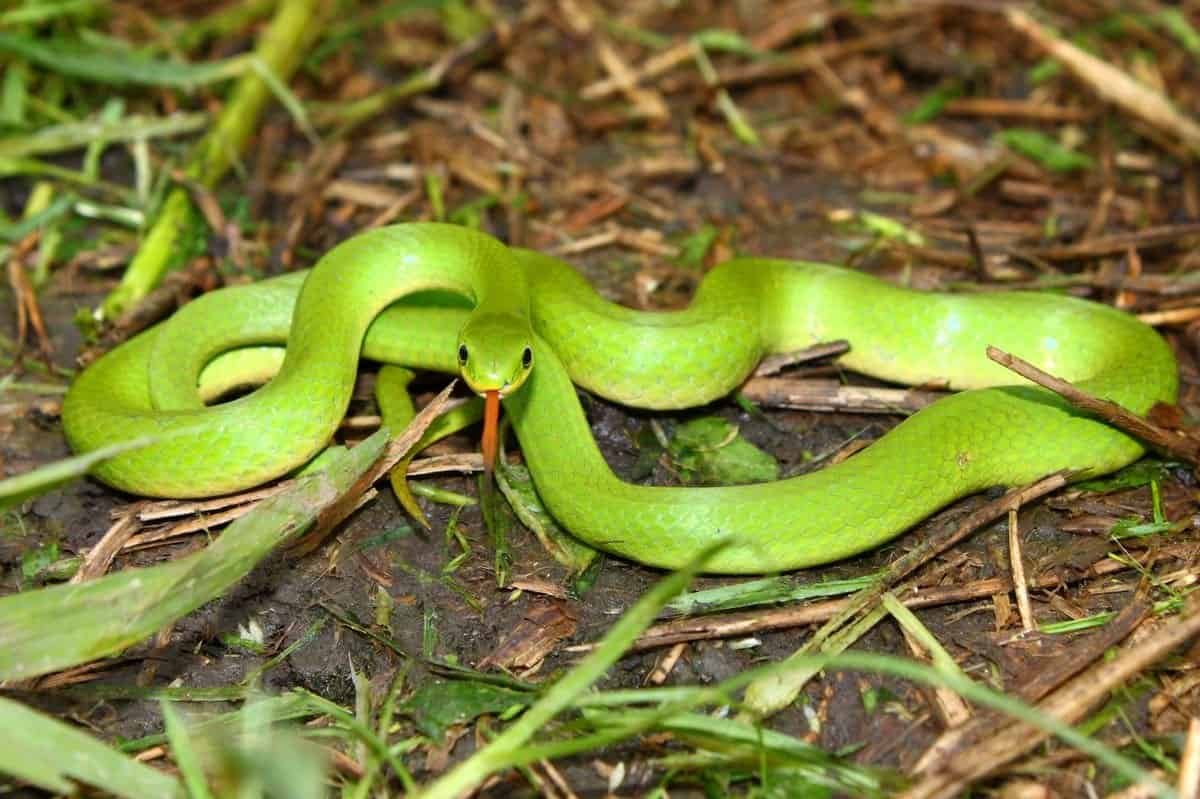
The smooth green snake is a small, slender species you might come across in your backyard. You’ll know it by its bright green color and those shiny, smooth scales. It’s easy to tell apart from other green snakes because its scales are extra sleek. Almost silky, really.
These snakes aren’t dangerous at all. No venom, and they almost never bite people. Smooth green snakes love eating insects and spiders, so they’re great for keeping bug populations down.
Look for them in grassy spots or low bushes. Their green color is perfect camouflage in the vegetation. They’re pretty small—just 12 to 20 inches long—and their thin bodies make them easy to miss as they slip through the grass.
If you live up north, you’ve got a better shot at spotting one. They like cooler climates and aren’t found in places like Florida. Smooth green snakes are shy. If you see one, it’ll probably disappear fast rather than hang around.
Snake Safety And Identification
Knowing how to spot the difference between dangerous and harmless snakes can make a big difference for your family’s safety. It comes down to learning a few key features and behaviors to help you figure out what you’re looking at.
Recognizing Venomous Versus Non-Venomous Snakes
Most backyard snakes aren’t dangerous, but it’s smart to know what to watch for. Venomous snakes in North America have a few telltale signs.
- Head Shape and Eyes Venomous snakes usually have triangle-shaped heads that are wider than their necks. Their eyes have vertical, slit-like pupils. Nonvenomous snakes have narrow heads and round pupils. Their heads flow smoothly into their necks—no sharp division.
- Body Patterns Many venomous snakes show off bright warning colors or bold patterns. Coral snakes, for instance, have red, yellow, and black bands. There’s that old rhyme: “Red touches yellow, kills a fellow. Red touches black, friend of Jack.”
- Tail Features Rattlesnakes have obvious rattles on their tails. Cottonmouths and copperheads have thick, short tails that taper off quickly. Harmless snakes usually have long, thin tails that taper gently to a point.
Safe Ways to Observe Backyard Snakes
Don’t try to catch or handle any snake you find in your yard. Even the so-called harmless ones can bite, and nobody wants to deal with an infection.
- Keep Your Distance Give snakes some space—at least 6 feet is a good rule. Most snakes can strike about half their body length, which is honestly farther than you’d expect. Grab some binoculars or just use your phone’s zoom if you want a closer look. That way, you can check out their markings without getting too close for comfort.
- Move Slowly Sudden moves? Not a great idea. Snakes spook easily and might get defensive. If you spot one, just back away slowly and avoid drama. Don’t trap a snake or block where it wants to go. Let it have a clear exit, and it’ll likely leave you alone.
- Watch Where You Step Snakes love hiding under logs, rocks, or in tall grass. Always check these spots before you reach or step—just in case. If you’re working in the garden, wear closed-toe shoes and long pants. It’s a simple way to avoid accidental bites.
When to Seek Professional Help
Call a wildlife control expert if you spot venomous snakes around. Seriously, don’t try to remove them yourself.
- Multiple Snake Sightings Seeing several snakes in a short time? There might be a den nearby. Professionals know how to relocate them safely. Lots of snakes usually means there’s plenty of food around—think rodents or frogs.
- Snakes Near Your House If snakes get inside your home, garage, or shed, it’s time to call for help. They’re probably looking for shelter or a snack. Look for gaps under doors or holes in the foundation where snakes might slip inside.
- Aggressive Behavior Most snakes just want to get away from people. But if one stands its ground or acts aggressive, keep everyone away and call the experts. Skip the home remedies and don’t try to kill snakes yourself—it rarely ends well.
Keeping Snakes Away Naturally
If you want fewer snakes, focus on making your yard less appealing. Remove what attracts them and use safe deterrents. Get rid of food sources, shelter, and water, and put up barriers that make them think twice about visiting.
Tips for Minimizing Snake Habitats
- Remove food sources that attract snakes. Keep garbage cans sealed, clean up bird seed spills, and store pet food inside. Fix any leaks that leave water sitting around.
- Cut back vegetation often to reduce hiding spots. Mow the grass, trim bushes away from your house, and clear out brush piles, wood stacks, and tall weeds—these are prime snake real estate.
- Seal entry points around your property. Block gaps under decks, sheds, and porches with hardware cloth or concrete. Patch up holes in the foundation as soon as you spot them.
- Clear debris from your yard. Get rid of rock piles, old lumber, and any unused equipment. Store firewood at least 20 feet from the house and keep it off the ground if you can.
- Install proper drainage to avoid standing water. Fix leaky hoses and get rid of puddles—snakes need to drink too. If you have water features you don’t use, consider removing them.
Pet and Family-Friendly Prevention Methods
- Plant natural repellent plants like marigolds, lemongrass, or wormwood around your property. These smell bad to snakes but look great and are safe for kids and pets.
- Use scent deterrents that won’t harm your family. Try spraying white vinegar around the garden or entry points. Some folks sprinkle cinnamon or clove oil where they’ve seen snakes hanging out.
- Encourage natural predators to visit. Set up owl boxes or bird houses—birds eat snakes, and so do guinea fowl. Even cats help keep the numbers down.
- Create physical barriers with safe materials. Fine mesh fencing that goes 6 inches underground works well. Metal flashing around garden beds can stop snakes—they just can’t get a grip on it.
- Keep outdoor areas clean and bright. Snakes prefer dark, quiet places. If you keep things tidy and well-lit, they’ll probably look elsewhere for a home.
Conclusion
Spotting a snake in your backyard? Totally normal. In fact, just about every backyard in America has at least one snake species hanging around somewhere close by.
The good news? Most of the snakes you’ll come across aren’t dangerous at all. They’re out there quietly taking care of pests like mice and insects. They’re doing you a favor by being in your yard.
No need to freak out if you see one slithering by. Just keep in mind:
- Most backyard snakes are non-venomous
- They’d rather avoid people
- They help control bugs and rodents naturally
- A lot of them are actually pretty useful to have around
We actually have an entire article on ways to create a snake-friendly garden, if you decide you’d like to take advantage of the many benefits snakes can offer. Or just do the opposite of everything in that article to ensure your yard is not appealing to snakes.
Some practical tips for coexisting with backyard snakes:
- Try to learn which snake species live near you
- If you see a snake, just give it some space
- If you’re worried, clear away brush piles and other hiding spots
- Keep the yard tidy to avoid attracting rodents in the first place
So next time you see a snake in your yard, don’t panic. Try to remember that it is likely harmless and that it is helping you out with a pest problem. Keep your distance and try to identify it if you can. If you suspect it might actually be dangerous, call a professional.
Leave a Reply